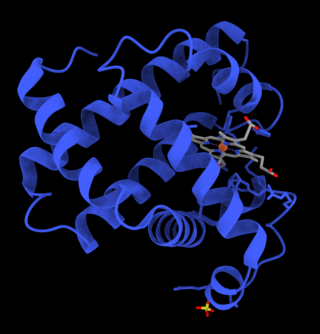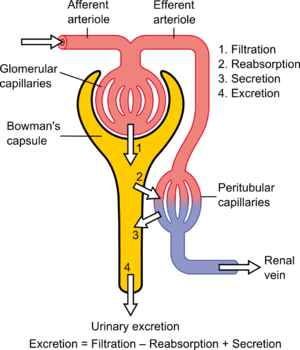
Myoglobin is an iron- and oxygen-binding protein found in the cardiac and skeletal muscle tissue of vertebrates in general and in almost all mammals. Myoglobin is distantly related to hemoglobin. Compared to hemoglobin, myoglobin has a higher affinity for oxygen and does not have cooperative binding with oxygen like hemoglobin does. In humans, myoglobin is only found in the bloodstream after muscle injury.
In physiology, body water is the water content of an animal body that is contained in the tissues, the blood, the bones and elsewhere. The percentages of body water contained in various fluid compartments add up to total body water (TBW). This water makes up a significant fraction of the human body, both by weight and by volume. Ensuring the right amount of body water is part of fluid balance, an aspect of homeostasis.

Inulins are a group of naturally occurring polysaccharides produced by many types of plants, industrially most often extracted from chicory. The inulins belong to a class of dietary fibers known as fructans. Inulin is used by some plants as a means of storing energy and is typically found in roots or rhizomes. Most plants that synthesize and store inulin do not store other forms of carbohydrate such as starch. In the United States in 2018, the Food and Drug Administration approved inulin as a dietary fiber ingredient used to improve the nutritional value of manufactured food products. Using inulin to measure kidney function is the "gold standard" for comparison with other means of estimating glomerular filtration rate.

Renal functions include maintaining an acid–base balance; regulating fluid balance; regulating sodium, potassium, and other electrolytes; clearing toxins; absorption of glucose, amino acids, and other small molecules; regulation of blood pressure; production of various hormones, such as erythropoietin; and activation of vitamin D.

Renal physiology is the study of the physiology of the kidney. This encompasses all functions of the kidney, including maintenance of acid-base balance; regulation of fluid balance; regulation of sodium, potassium, and other electrolytes; clearance of toxins; absorption of glucose, amino acids, and other small molecules; regulation of blood pressure; production of various hormones, such as erythropoietin; and activation of vitamin D.

Assessment of kidney function occurs in different ways, using the presence of symptoms and signs, as well as measurements using urine tests, blood tests, and medical imaging.
In pharmacology, bioavailability is a subcategory of absorption and is the fraction (%) of an administered drug that reaches the systemic circulation.
In pharmacology, clearance is a pharmacokinetic measurement of the volume of plasma from which a substance is completely removed per unit time. Usually, clearance is measured in L/h or mL/min. The quantity reflects the rate of drug elimination divided by plasma concentration. Excretion, on the other hand, is a measurement of the amount of a substance removed from the body per unit time. While clearance and excretion of a substance are related, they are not the same thing. The concept of clearance was described by Thomas Addis, a graduate of the University of Edinburgh Medical School.
Standardized Kt/V, also std Kt/V, is a way of measuring (renal) dialysis adequacy. It was developed by Frank Gotch and is used in the United States to measure dialysis. Despite the name, it is quite different from Kt/V. In theory, both peritoneal dialysis and hemodialysis can be quantified with std Kt/V.
Biological half-life is the time taken for concentration of a biological substance to decrease from its maximum concentration (Cmax) to half of Cmax in the blood plasma, and is denoted by the abbreviation .
In the physiology of the kidney, free water clearance (CH2O) is the volume of blood plasma that is cleared of solute-free water per unit time. An example of its use is in the determination of an individual's state of hydration. Conceptually, free water clearance should be thought of relative to the production of isoosmotic urine, which would be equal to the osmolarity of the plasma. If an individual is producing urine more dilute than the plasma, there is a positive value for free water clearance, meaning pure water is lost in the urine in addition to a theoretical isoosmotic filtrate. If the urine is more concentrated than the plasma, then free water is being extracted from the urine, giving a negative value for free water clearance. A negative value is typical for free water clearance, as the kidney usually produces concentrated urine except in the cases of volume overload by the individual.
In the physiology of the kidney, renal blood flow (RBF) is the volume of blood delivered to the kidneys per unit time. In humans, the kidneys together receive roughly 25% of cardiac output, amounting to 1.2 - 1.3 L/min in a 70-kg adult male. It passes about 94% to the cortex. RBF is closely related to renal plasma flow (RPF), which is the volume of blood plasma delivered to the kidneys per unit time.
Effective renal plasma flow (eRPF) is a measure used in renal physiology to calculate renal plasma flow (RPF) and hence estimate renal function. The eRPF can be calculated with

Acecainide is an antiarrhythmic drug. Chemically, it is the N-acetylated metabolite of procainamide. It is a Class III antiarrhythmic agent, whereas procainamide is a Class Ia antiarrhythmic drug. It is only partially as active as procainamide; when checking levels, both must be included in the final calculation.
The fractional excretion of sodium (FENa) is the percentage of the sodium filtered by the kidney which is excreted in the urine. It is measured in terms of plasma and urine sodium, rather than by the interpretation of urinary sodium concentration alone, as urinary sodium concentrations can vary with water reabsorption. Therefore, the urinary and plasma concentrations of sodium must be compared to get an accurate picture of kidney clearance. In clinical use, the fractional excretion of sodium can be calculated as part of the evaluation of acute kidney failure in order to determine if hypovolemia or decreased effective circulating plasma volume is a contributor to the kidney failure.
Acid–base homeostasis is the homeostatic regulation of the pH of the body's extracellular fluid (ECF). The proper balance between the acids and bases in the ECF is crucial for the normal physiology of the body—and for cellular metabolism. The pH of the intracellular fluid and the extracellular fluid need to be maintained at a constant level.
Extraction ratio is a measure in renal physiology, primarily used to calculate renal plasma flow in order to evaluate renal function. It measures the percentage of the compound entering the kidney that was excreted into the final urine.
Para-aminohippurate (PAH) clearance is a method used in renal physiology to measure renal plasma flow, which is a measure of renal function.

Aminohippuric acid or para-aminohippuric acid (PAH), a derivative of hippuric acid, is a diagnostic agent useful in medical tests involving the kidney used in the measurement of renal plasma flow. It is an amide derivative of the amino acid glycine and para-aminobenzoic acid that is not naturally found in humans; it needs to be IV infused before diagnostic use.

Sinistrin is a naturally occurring sugar polymer or polysaccharide, also known as polyfructosane. It belongs to the fructan group, like inulin. As it is the case with similar substances, such as fructans or inulin, sinistrin acts as an energy storage molecule in plants.








